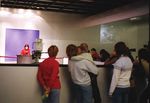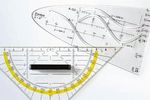The Tangible Interaction Framework Cards
←
→
Page content transcription
If your browser does not render page correctly, please read the page content below
The Tangible Interaction Framework Cards - Introduction
The following card set is based on the ‘Tangible Inter- How to work with the cards: the irrelevant ones). What works well is to spread rel-
action Framework’. The cards pose provocative ques- evant cards out, clustering them into themes on your
To start: mix the cards and distribute them so every-
tions for a brainstorming exercise which can be used work surface.
one has “a hand”. Then, you take turns, as in usual
in order to generate design ideas or to analyse a given
card games. Usually there is also a cluster of half-relevant cards,
design or system. The exercise works best if you
which somehow are not interesting or don‘t fully
already have an inital undertanding of your problem The following describes a basic process, but you are
apply. This is OK as well.
space and the core aims of the project and if you still free to vary this. You can write on the back of the
have the freedom to make something out of the ideas cards, use additional post-it notes, or experiment with The next person having their turn has to pick a new
and insights generated. including other materials in the brainstorming process card from their own hand.
(e.g. photos from your own ethnographic studies of
Print the following pages out one-sided, if feasible on What works well as a (softly applied) game rule is to
the use context).
thick paper, and cut them into separate cards using a require picking a different colour or arguing for a differ-
guillotine (or scissors). Core rules and process: ent decision regarding relevance/ irrelevance (referring
to how the previous card was played out).
For a group of up to four people doing a brainstorming Pick a card from your hand that you think is relevant
session, one set of cards will be enough. For larger (or that you think is irrelevant) and explain why. The main aim of this is to prevent groups from getting
groups, you may want to print two sets. into a routine of ‘this is irrelevant, this is irrelevant…‘,
The group has to agree on this (the discussion out-
to give people something that triggers new ideas
Each card has one or two provocative/sensitizing come might be other than the initial suggestion) -
when discussion falters, and to make them move
question on it, plus 1-2 pictures which illustrate these. negotiating and discussing why or why not it might be
between the themes of the original framework.
relevant and what ideas it gives you is the main point
In addition the concept from the original framework
of the exercise!
that the question belongs to is given in small print.
The cards are furthermore colour-coded according to Seemingly “irrelevant” cards can sometimes inspire
the framework themes. Focus on the questions and new ideas, so give yourself freedom to think outside
images in working with the cards - they are to help the box and to ask ‘what-if‘ questions. Be playful in
you brainstorm and to serve as inspiration and provo- disagreeing with each other ;-)
cation to think about. The Tangible Interaction Framework was developed
You have freedom to interpret the cards as it fits your
by Eva Hornecker. Get in touch with her via
Sessions will usually take between one and two project or to decide that you should do the exact
eva@ehornecker.de or http://www.ehornecker.de.
hours. This means you will sometimes need to pace opposite. The cards are merely things to think about,
the brainstorming as you can easily get into long and not guidelines or rules.
very interesting discussions triggered by one card. In
Once the group has agreed, the card is placed accord-
this case you might want to take notes and return to Design: Elisabeth Eichhorn
ing to the outcome with the other relevant cards (or
an idea later-on. http://www.elisabetheichhorn.de
Can users grab, feel and move Is there rapid feedback
“the important stuff”? during interaction?
Tangible Manipulation > Haptic Direct Manipulation Tangible Manipulation > Lightweight Interaction
Can users proceed with small, Can users experience the
experimental steps? interaction straight away,
from the start?
Tangible Manipulation > Lightweight Interaction Tangible Manipulation > Lightweight Interaction
Do people and objects meet How can the human body
and invite into interaction? relate with the space?
Spatial Interaction > Inhabited Space Spatial Interaction > Inhabited Space
Can you create a meaningful Does shifting stuff (or your own
place with atmosphere? body) around have meaning?
Spatial Interaction > Inhabited Space Spatial Interaction > Configurable Materials
Can everybody see and follow Can you use your whole body?
what‘s happening? Bodily interaction is enlivening, expressive,
observable, performative.
Spatial Interaction > Visual Access Spatial Interaction > Full-Body Interaction
Can users take ownership of Can users be proud of skilled
space by physically moving body movement?
there? Can they develop skill over time?
Spatial Interaction > Full-Body Interaction Spatial Interaction > Full-Body/Performative
Can you communicate through Are actions publicly available?
your body movements while
doing what you do?
Spatial Interaction > Performative Actions Spatial Interaction > Performative Actions
Does the physical set-up lead Is there a physical focus that
users to collaborate by subtly draws the group together?
constraining their behavior?
Embodied Facilitation > Embodied Constraints Embodied Facilitation > Embodied Constraints
Can all users get their hands on Can you hand over control
the central objects of interest? anytime, and fluidly share
an activity?
Embodied Facilitation > (Multiple) Access Points Embodied Facilitation > (Multiple) Access Points
Does the representation build What is the entry threshold for
on users’ experience and interaction?
(Can you provide a simple syntax of interaction regardless
connect with their skills? of the semantics?)
Embodied Facilitation > Tailored Representations Embodied Facilitation > Tailored Representations
Are representations legible, Are physical and digital
meangingful, and expressive? representations of similar
Are they of lasting relevance? strength? Can they augment and complement each other?
Expressive Representation > Representational Significance Expressive Representation > Representational Significance
Can users think or talk with/ Does the representation give
through objects, using them as discussions a focus and provide
props to act with? a record (trace)?
Expressive Representation > Externalization Expressive Representation > Externalization
How easy is it to understand Are there powerful represen-
the relations between action tations that transform the
and effects? Can you give “fake” causal feedback? problem?
Expressive Representation > Perceived Coupling and Power Expressive Representation > Perceived Coupling and Power
You can also read



























































